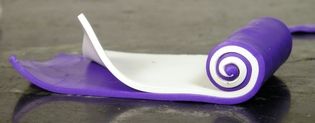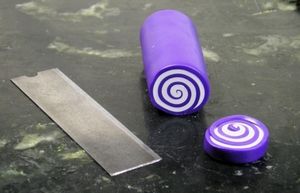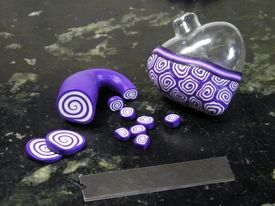
|
|
|

|
The Artwork |
| The designs you see on the objects in the Gallery are not painted, they are instead made using polymer clay canes. Polymer clay is an artist's modeling compound made from the material known as PVC (polyvinylchloride--also used for plastic plumbing pipes). It can be found in craft and artist supply stores and comes in a rainbow of colors and variety of brands--Fimo®, Kato Polyclay®,Premo®,and Sculpey® to name just a few. A cane is a loaf of material, in which a design runs continuously through its length. When the cane is sliced perpendicular to its length (like a loaf of bread), each slice reveals a copy of the design. These cane slices are then used to decorate the objects. The technique of caning has been practiced, using colored earthen clay or glass, since at least two thousand years B.C. Venetian glass blowers used canes, made from glass rods fused together under high heat, to make Millefiore (Italian: "thousand flowers"), a type of glassware that is decorated with caned geometric or flowered designs. The polymer clay canes used for the artwork on this site, are generally made from colored polymer clay that has been rolled into sheets. |
 Polymer clay, as packaged, can vary in consistency from hard, and crumbly like parmagiano cheese, to soft and stretchy like silly-putty. Before the polymer clay can be formed into sheets needed to make a cane, it must first be conditioned. Conditioning makes the clay more pliable and also serves as a way to mix the clay's color. Depending on the brand of clay (and sometimes between different colors within a brand),different conditioning techniques are warranted. Hard, crumbly clay is more easily conditioned by first chopping the clay in a mini food processor. The resulting particles are then rolled together and kneaded by hand until the mass of clay is soft and pliable. Softer types of clay still require some kneading to make them suitable for use. After the required conditioning, the polymer clay is then ready to be formed into sheets. |
 Conditioned polymer clay can be formed into sheets, by hand, using a rolling pin, brayer, or other suitable cylindrical object, but the easiest and most convenient tool to use is the pasta machine. The pasta machine, with a simple adjustment, is able to produce polymer clay sheets in a variety of thicknesses that are relatively consistent in their thickness. Sheets produced with a pasta machine are superior for producing canes with crisp and detailed designs. The pasta machine, in addition to being a clay conditioning tool, is also helpful in making sheets of clay with color gradations, also known as "Skinner Blends". Canes made with the Skinner blended sheets, and designs made from these canes, are especially pleasing as many visual effects are possible using color gradations. |
 The general method for making a cane from sheets of polymer clay is simply demonstrated in the construction of the "jelly-roll" or spiral design cane. Generally, the designs in polymer clay canes are made by either stacking sheets of clay, or rolling sheets of clay. In this cane, two different colored sheets of clay are stacked one atop the other. This stack of two sheets is then rolled up from one end, just like a jellyroll. Slicing into the resultant roll reveals the spiral design on/in each slice of the roll. Check the Tutorials section to see other designs are made.  |
 Polymer clay works as a caning material because it, like glass, possesses the property of being able to maintain separation of colors while being manipulated. Because of this property, the design can be built as cane in a convenient size to work with, and then it can be reduced, by carefully compressing and stretching the cane lengthwise. The process of reduction makes the design smaller, but it also serves to make more copies of a particular design since the cane is lengthened and therefore more slices can be taken from the cane. It is also possible to shape the cane during the reduction process so that, for example, a round spiral design cane could be shaped into a square or triangular shaped spiral cane. Canes with relatively simple designs can also be combined and reduced to produce detailed designs of kaleidoscopic complexity. Once the canes are made and reduced to the sizes needed, they are sliced using a sharp razor blade. The individual cane slices are then carefully applied to blown glass Christmas ornaments, metal tins, blown-out chicken eggs, or other suitable items. After the object is decorated, the slices are smoothed together and the polymer clay is hardened by baking in an oven at a temperature of ~265°F. After cooling, the piece is sanded with progressively finer grades of sandpaper and then either buffed, or coated with some type of clear finish such as Varathane®, a water based polyurethane wood flooring finish. This final buffing or finishing step further accentuates the colors and designs that are possible with polymer clay caning. Caning is but one way to use polymer clay as an artistic medium to create decorative objects. There are many other techniques used to create a wide range of designs, effects, and even imitations of naturally found materials. Check the Links section for more information about polymer clay. |